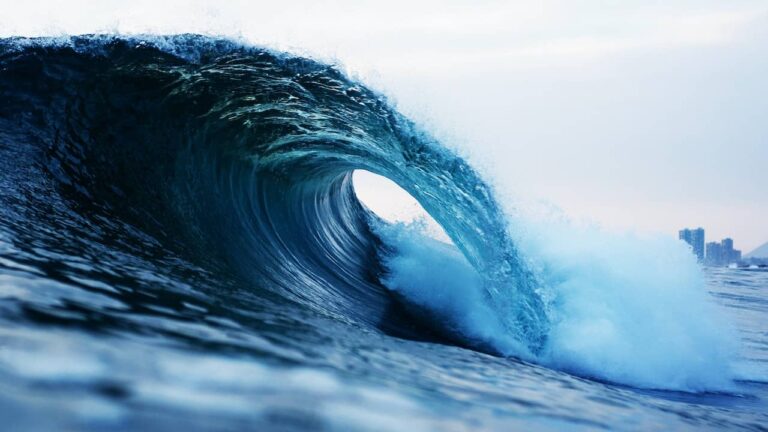Tidal energy, at its core, is all about the power of the ocean’s tides. But what makes these tides a powerhouse? It’s the gravitational pull of the moon and sun, in tandem with Earth’s rotation, that creates the ebb and flow of the sea.
This movement of water, consistently back and forth, is a kinetic energy source ripe for the picking.But how do we tap into this energy? That’s where tidal energy systems come into play.
Table of Contents
Types of tidal energy technologies
There are three primary technologies that harness the power of tides:
- Tidal barrages
Tidal barrages are large structures built across estuaries or bays. They consist of a series of turbines or generators that are strategically placed within the barrage. As the tide rises, water flows into the estuary, and as it falls, the water is released back into the sea.
This movement of water through the barrage causes the turbines to rotate, generating electricity. The key advantage of tidal barrages is their ability to produce large amounts of consistent power due to the predictable nature of tides.
- Tidal lagoons
Tidal lagoons operate similarly to tidal barrages but in different settings. These are man-made structures that enclose a body of water, typically along the coast. They consist of a seawall or barrier with turbines installed within it.
As the tide comes in, water fills the lagoon through gates, and as the tide recedes, the water is released through the turbines. This flow of water drives the turbines and generates electricity. Tidal lagoons offer the advantage of being able to control the flow of water, enhancing their efficiency and power generation potential.
- Tidal turbines
Tidal turbines, otherwise called tidal stream turbines or underwater turbines, harness the power of strong underwater tidal currents, much like wind turbines utilize wind power. We install these turbines on the ocean floor or on structures like frames or pylons.
The flowing tidal current sets the turbine’s rotor blades into motion, producing mechanical energy. This energy then transforms into electrical power through a generator. With their modular design, we can deploy tidal turbines either singly or in groups, offering the flexibility to increase energy production as needed.
Advantages
Tidal Power Station holds numerous advantages as a renewable energy source. Let’s explore some of its key benefits:
- Predictability: tides are highly predictable and follow a regular pattern based on lunar and solar gravitational forces. Unlike other renewable energy sources like solar and wind, which are intermittent and dependent on weather conditions, tidal energy can be reliably forecasted. This predictability allows for better planning and integration into the grid, ensuring a steady and consistent power supply;
- Sustainability: tidal energy is a sustainable and renewable source of power. The energy is derived from the natural movement of the tides, which are driven by gravitational forces. As long as the Earth, moon, and sun continue to exist, tidal energy will persist. It does not deplete or consume any resources, making it a reliable long-term energy solution;
- Efficiency: tidal energy boasts a high energy density, meaning it can generate significant power in a relatively small area. The density of water is around 800 times greater than that of air, which translates to a greater potential for energy capture. Systems, such as barrages and turbines, can efficiently convert the kinetic energy of moving water into electricity.
Disadvantages
While this technology offers several advantages, it also has certain drawbacks. Let’s explore some of the disadvantages of tidal energy:
- Cost: one of the primary disadvantages of tidal energy is the high upfront cost of implementing tidal energy projects. Building and installing tidal barrages, lagoons, or turbines can require a significant financial investment. Infrastructure construction in challenging marine environments, such as offshore locations, adds to the overall cost;
- Environmental concerns: while tidal Power Station is considered a clean and renewable energy source, its installation and operation can have environmental impacts. Constructing tidal barrages or lagoons may disrupt the natural flow of water and sediment. This will potentially affect local ecosystems and marine habitats. Proper environmental assessments and mitigation measures are crucial to minimize these impacts.
Read also: Blue Economy: what is it and what are its main components and principles
Examples of tidal power stations
Here are a few examples of notable tidal power stations around the world:
- La Rance Tidal Power Plant (France): Located on the Rance River estuary in Brittany, France, the La Rance Tidal Power Plant is one of the world’s oldest and largest tidal power stations. It began operation in 1966 and consists of 24 turbines with a total installed capacity of 240 megawatts (MW). The plant takes advantage of the large tidal range in the area, generating electricity from the rise and fall of the tides;
- Sihwa Lake Tidal Power Station (South Korea): Situated on the west coast of South Korea, the Sihwa Lake Tidal Power Station is the world’s largest tidal power plant in terms of installed capacity. It started operation in 2011 and has an installed capacity of 254 MW. The power station utilizes a tidal barrage across the mouth of Sihwa Lake. It captures energy from the tidal flow to generate electricity.
The future of tidal energy
The future of tidal energy holds great promise as advancements in technology, supportive policies, and market growth drive its development. Ongoing research and development efforts are focused on improving the efficiency and cost-effectiveness of tidal power station systems.
Governments are implementing supportive policies and regulations to incentivize tidal power stations while increasing demand for clean energy, and efforts to reduce carbon emissions are driving market growth. International collaborations and successful case studies are further accelerating the adoption of tidal energy.
With its predictability, sustainability, and low environmental impact, tidal energy has the potential to significantly contribute to the global renewable energy landscape, creating a more sustainable and resilient energy future.
Read also: What is the Waveline Magnet: one of the best inventions for cheap and clean energy












